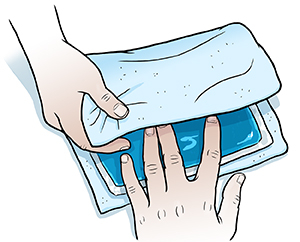Treating Osgood-Schlatter Disease
Osgood-Schlatter disease is a condition that affects the knee most often in active, growing teens. You likely have pain and swelling below the kneecap. This is where the patellar tendon attaches to the shinbone (tibia). This condition will go away on its own once you stop growing. But your symptoms and pain will need to be treated until then. How soon your knee gets better is up to you. To help your knee heal, try resting and icing it. You may want to wear a special knee strap or knee padding.
Giving your knee a rest
To know how much you should rest the knee, let pain be your guide. If you feel a lot of pain, stay off the knee as much as you can. Don't jump, walk up or down stairs, kneel, or do activities that cause pain. If your pain is mild, try swimming or other sports that don’t put as much stress on the knee. As the pain lessens, ease back into your normal routine.
Reducing pain and swelling
If the pain and swelling really bother you, try icing your knee for 10 to 15 minutes a few times a day. You can try over-the-counter medicine, such as ibuprofen, to help reduce swelling. First ask your healthcare provider what kind of medicine to take. Don't take medicine that contains aspirin. Aspirin is dangerous for anyone who’s not an adult. Your healthcare provider can give you the details.
 |
| Always wrap ice in a thin towel before putting it on your knee. |
Wearing a knee strap
Your healthcare provider may give you a special knee strap to wear. It can ease some of the pressure on your knee. You can wear it when playing sports and even when just walking around. Wear the strap right below your kneecap but above the bump formed by the tibial tubercle. Padding can also help with irritation to the area.
If your problem is severe
Sometimes, resting your knee isn’t enough to make it better. You may need more medical treatment. Immobilization is a type of treatment that keeps you from moving the knee. You may need to wear a brace or a cast for a few weeks. During that time, you’ll walk with crutches. Later, you’ll need to regain flexibility and strength in your knees and legs. You can then ease into your normal routine. But if your knee hurts, rest it until you feel better.
When to call the healthcare provider
After a few weeks of self-care, your knee should feel better. But let your healthcare provider know if the pain gets worse, or if it doesn't go away with rest.
Online Medical Reviewer:
L Renee Watson MSN RN
Online Medical Reviewer:
Raymond Turley Jr PA-C
Online Medical Reviewer:
Thomas N Joseph MD
Date Last Reviewed:
1/1/2022
© 2000-2024 The StayWell Company, LLC. All rights reserved. This information is not intended as a substitute for professional medical care. Always follow your healthcare professional's instructions.